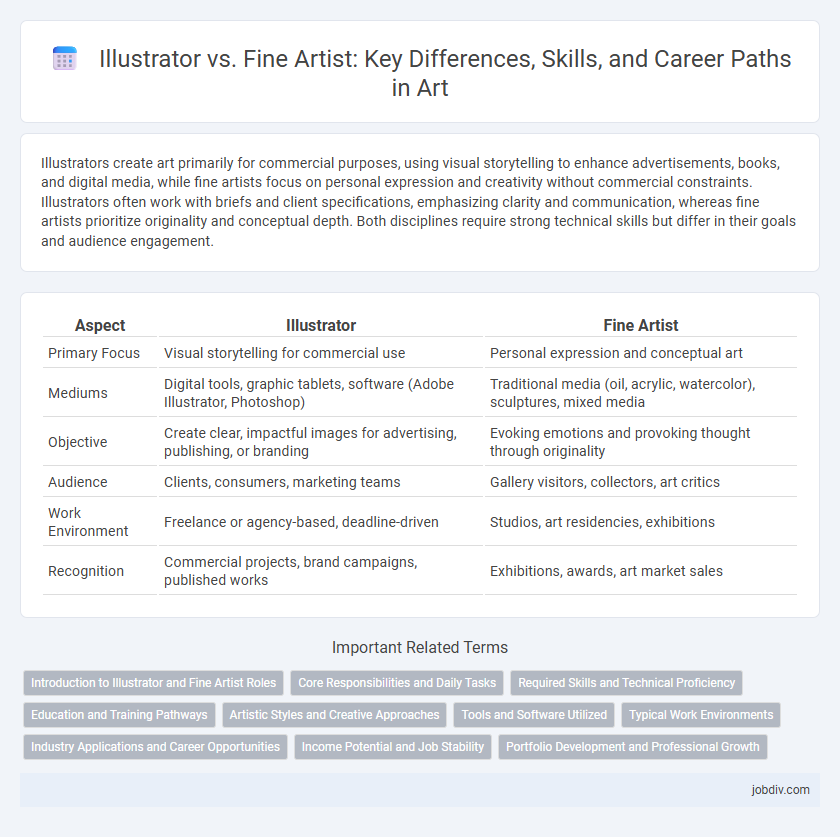Illustrators create art primarily for commercial purposes, using visual storytelling to enhance advertisements, books, and digital media, while fine artists focus on personal expression and creativity without commercial constraints. Illustrators often work with briefs and client specifications, emphasizing clarity and communication, whereas fine artists prioritize originality and conceptual depth. Both disciplines require strong technical skills but differ in their goals and audience engagement.
Table of Comparison
| Aspect | Illustrator | Fine Artist |
|---|---|---|
| Primary Focus | Visual storytelling for commercial use | Personal expression and conceptual art |
| Mediums | Digital tools, graphic tablets, software (Adobe Illustrator, Photoshop) | Traditional media (oil, acrylic, watercolor), sculptures, mixed media |
| Objective | Create clear, impactful images for advertising, publishing, or branding | Evoking emotions and provoking thought through originality |
| Audience | Clients, consumers, marketing teams | Gallery visitors, collectors, art critics |
| Work Environment | Freelance or agency-based, deadline-driven | Studios, art residencies, exhibitions |
| Recognition | Commercial projects, brand campaigns, published works | Exhibitions, awards, art market sales |
Introduction to Illustrator and Fine Artist Roles
Illustrators create visual content primarily for commercial use, including books, advertisements, and digital media, using techniques that emphasize clear communication and storytelling. Fine artists produce original works focused on aesthetic expression and conceptual depth, often exhibited in galleries and museums. Both roles require strong artistic skills, but illustrators prioritize client briefs and market appeal, while fine artists focus on personal vision and artistic exploration.
Core Responsibilities and Daily Tasks
Illustrators primarily create visual representations for commercial purposes such as books, advertisements, and digital media, focusing on meeting client specifications and deadlines. Fine artists concentrate on producing original works meant for exhibition and sale, emphasizing personal expression, conceptual development, and mastery of traditional or contemporary techniques. Daily tasks for illustrators involve collaborating with clients and revising artwork, while fine artists spend more time experimenting with mediums and preparing pieces for galleries.
Required Skills and Technical Proficiency
Illustrators require advanced proficiency in digital tools like Adobe Illustrator, Photoshop, and tablet drawing software to create precise and versatile artwork for commercial use. Fine artists emphasize mastery of traditional techniques such as painting, sculpture, and mixed media, alongside a deep understanding of composition, color theory, and art history. Both fields demand strong creativity and visual communication skills, but illustrators prioritize technical versatility while fine artists focus on expressive craftsmanship and conceptual depth.
Education and Training Pathways
Illustrators typically pursue specialized education in graphic design, digital media, or commercial art programs emphasizing software proficiency and visual communication skills. Fine artists often follow a broader academic pathway through fine arts degrees, focusing on techniques, art history, and conceptual development to cultivate a unique artistic voice. Both pathways require rigorous practice, but illustrators prioritize client-driven projects while fine artists engage in personal expression and gallery exhibitions.
Artistic Styles and Creative Approaches
Illustrators often employ precise, commercial styles tailored for storytelling and visual communication, utilizing digital tools to create clear, reproducible images for books, advertising, and media. Fine artists prioritize personal expression and conceptual depth, exploring diverse media and experimental techniques to evoke emotions and provoke thought. Both disciplines embrace creativity but diverge in purpose, with illustrators aiming for clarity and functionality while fine artists pursue innovation and subjective interpretation.
Tools and Software Utilized
Illustrators predominantly use digital tools such as Adobe Illustrator, Photoshop, and Procreate to create precise, scalable artwork tailored for commercial projects like advertising and publishing. Fine artists often rely on traditional mediums including oil paints, charcoal, and canvas, although some also incorporate digital software like Corel Painter or Adobe Photoshop to enhance or conceptualize their pieces. The choice of tools and software shapes the workflow and final output, distinguishing the commercial focus of illustrators from the expressive intent of fine artists.
Typical Work Environments
Illustrators typically work in digital studios or design agencies, using software like Adobe Illustrator and Photoshop to create visual content for advertising, books, and media. Fine artists often operate in private studios or galleries, focusing on traditional mediums such as painting, sculpture, and mixed media to express personal or conceptual themes. Both environments demand creativity but differ in workflow, collaboration, and commercial versus artistic goals.
Industry Applications and Career Opportunities
Illustrators typically work in commercial industries such as publishing, advertising, and digital media, creating visuals tailored for marketing campaigns, book covers, and product packaging, which demands proficiency in digital tools like Adobe Illustrator and Photoshop. Fine artists, in contrast, focus on creating original artworks for galleries, exhibitions, and private collectors, often emphasizing personal expression and traditional mediums like painting and sculpture, with career opportunities extending to teaching and residencies. Both fields offer diverse career paths, but illustrators generally find more steady employment in client-driven projects, while fine artists navigate a more varied market centered around art sales and commissions.
Income Potential and Job Stability
Illustrators often benefit from more consistent income streams through commissions, freelance projects, and contracts with publishers or advertising agencies, offering relatively higher job stability. Fine artists face variable income potential, heavily dependent on art sales, gallery representation, and market demand, which can lead to unpredictable financial fluctuations. Strategic marketing and diversifying revenue sources increase earning potential and financial security for both professions.
Portfolio Development and Professional Growth
Illustrators develop portfolios showcasing versatility in digital tools and commercial projects, emphasizing client-driven work and adaptability across media. Fine artists focus portfolios on personal expression, originality, and conceptual depth, often highlighting gallery exhibitions and art residencies. Professional growth for illustrators relies on networking with agencies and clients, while fine artists advance through art shows, grants, and critical recognition.
Illustrator vs Fine Artist Infographic

 jobdiv.com
jobdiv.com